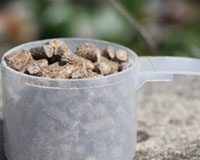 It’s rampant and insidious, and sometimes invisible. It can destroy a hoof from the inside out, causing a horse to become inexplicably lame.
It’s rampant and insidious, and sometimes invisible. It can destroy a hoof from the inside out, causing a horse to become inexplicably lame.
In the past, thrush was considered by many horse owners to be just a minor annoyance, but in recent years, the damage that can be caused by thrush has become well known, especially among farriers specializing in barefoot trimming.
“Thrush is harmful to horses for many reasons,” says farrier Kelly Mount, based in Gavilan Hills, Calif. “Thrush is painful, and can cause a horse to become ‘ouchy.’ It can also cause horses to move with a toe-first landing on the hoof, which causes improper foot mechanics. This can lead to other problems, like underdeveloped frogs, contracted heels, and caudal hoof pain.”
In nature, horses rarely suffer from thrush because they live in a clean, dry environment. Stalled horses are forced to stand in small spaces with their own feces and urine. Even stalls that are frequently cleaned can expose horses to the organic waste that cause thrush to thrive. Wild horses also have access to a varied, low-carbohydrate diet, which also helps keep them free from thrush.
“Environment is a big factor, but stubborn thrush is commonly the result of an imbalanced diet too high in carbohydrates,” says Mount.
The most obvious way to determine if your horse has thrush is to look for a foul-smelling black discharge when cleaning the hoof. But just because you don’t see or smell thrush, doesn’t mean your horse doesn’t have it. Some hooves appear healthy, showing no signs of the condition on the outside. The inside of the hoof is a different story, however. Your farrier will see signs of thrush once he or she begins removing areas of dead frog or sole.
If you suspect your horse has thrush, you can do a lot to get the infection under control and keep it at bay:
- Pick daily. Using a hoof pick, clean out your horse’s feet every day. Be sure to clean thoroughly all around the frog. If the horse is barefoot, clean out the white line area as well.
- Wash. After picking out the hooves, use a garden hose to rinse each hoof with water, whenever possible. Twice a week, wash the hoof with Betadine scrub.
- Treat. As often as possible, inject a mixture of antibiotic ointment and athlete’s foot cream into the cleft of the frog. You can also soak the horse’s hooves in a product called White Lightening, using a hoof boot, several times a week. Don’t overuse harsh over-the-counter thrush remedies since they can also damage healthy hoof tissue.
- Dry stall. Clean manure from your horse’s stall at least once daily, along with soiled bedding. If your horse is in a dirt paddock, cover over urine spots with decomposed granite or a drying product made for use with livestock.
- A good farrier. Make sure your farrier is giving your horse a trim that has him landing heel-first. Work with your farrier to find out where areas of thrush are present in your horse’s hooves so you can focus on those spots with treatment.
- Movement. Get your horse to move as much as possible. Movement helps circulation in the hoof and aids in fighting infection.
- Diet. Limit the amount of carbohydrates your horse consumes. Grains, sweet feeds and rich legumes can contribute to thrush. Talk to your veterinarian about putting your horse on the lowest carbohydrate hay available in your area.
With diligence and persistence, you can get thrush under control and keep it from returning. Your reward will be a sound horse with happy feet.
Liked this article? Here are others you’ll enjoy:
Question of the Week: What is Thrush?
Guide to Horse Hoof Problems






Good practical information. Spring time is the worst around here with mud, mud, mud for weeks if not months at a time. I will be ready this spring.
Great advice. Especially for this time of year with so much MUD!